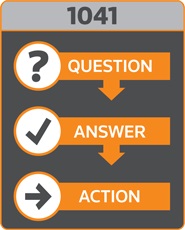How to handle wealth management issues.
Fiduciary tax comes with unique challenges. For starters, wealth management requires extra care, trust investments are becoming more complex, and distribution rules are ever changing.
As we know, governments collect taxes to fuel economic growth and fund investments in infrastructure, human capital, as well as the provision of services for individuals and businesses. This also extends to the income an individual receives after their death, which is subject to income tax.
The income taxation of estates and trusts may not garner as much attention as other areas of tax, so helping clients better understand the tax issues related to estates and trusts is important.
Navigating the complexities begins with having a solid grasp of the basics, like the fundamentals of fiduciary tax.
To help accounting professionals, especially those entering the profession, this article will explore how fiduciary income tax is different from estate tax, who files a fiduciary tax return, what defines estates and trusts, and more.
Jump to ↓
| What is fiduciary tax? |
| Estates and trusts |
| Filing Form 1041 |
| Fiduciary tax and state differences |
| Wealth management resources |
What is fiduciary tax?
In simplest terms, fiduciary income tax is the income taxation of a person‘s estate or trust assets.
Determining the taxable income for both estates and trusts may be similar to that of an individual, but there are noteworthy variations. The trust gets a deduction for the portion of the estate transferred to the beneficiary. What is remaining then becomes taxable income for the trust or estate. The trust or estate pays tax on the taxable income applicable to the estate or trust. The beneficiary pays tax on the assets they receive.
Examples of income-producing assets include, but are not limited to:
- Certificates of deposit
- Bonds
- Mutual funds
- Rental property
- Savings accounts
- Stocks
To report that income, the fiduciary of a decedent’s estate or trust needs to file Form 1041, the fiduciary income tax return. More specifically, the form reports:
- The income, deductions, gains, losses, etc., of the estate or trust.
- The income that is either accumulated or held for future distribution or distributed currently to the beneficiaries.
- Any income tax liability of the estate or trust.
- Employment taxes on wages paid to household employees.
To further illustrate the purpose of fiduciary tax, consider the following example:
Let‘s say a client‘s family member has died. The client is listed as the beneficiary of rental property owned by the decedent, but it takes two years before the client can take the property from the estate. The rental income that the rental property generates during those two years must be reported by the client on Form 1041.
It may be easy to confuse fiduciary tax with estate tax, but the differences are important, especially when it comes time to fill out tax forms.
Fiduciary tax vs. estate tax
While fiduciary income tax is the income taxation of a person‘s estate or trust assets, estate tax is a tax on the right to transfer property when a person passes away.
“I know we use those terms somewhat interchangeably but, when we’re talking about fiduciary income taxation, we‘re really talking about the income taxation of the assets that are in a person‘s estate or the income taxation of assets that are held in a trust. And this should be contrasted with the estate tax, which is really sort of a one-time tax that occurs at a person‘s death,” said Farhad Aghdami, Fellow at The American College of Trust and Estate Counsel (ACTEC), during the ACTEC webcast, “The Basics of Fiduciary Income Taxation.”
Aghdami continued, “Think about a farmer who owns an apple orchard, and the farmer passes away. There may be an estate tax due on the value of that apple orchard and you’d have an appraiser determine what the value is, and you would subtract any applicable deductions in a credit — there’s an $11.7 million estate tax credit that’s available — and that is sort of a one-time tax that is paid. The fiduciary income taxation, though, is the tax on what is generated by that property. If you‘ve got an apple orchard, you’re growing apples every year and the income is really the apples that are being grown every year.”
The income that is generated by the apple orchard would be reported on an annual income tax return.
Who files a fiduciary tax return?
Federal regulations require the filing of an income tax return, Form 1041, for estates and trusts. Why? Because, just like taxpayers are required to report their own income each year on a tax return, estates and trusts are also required by the IRS to pay income tax on their income.
The fiduciary is typically responsible for preparing and filing Form 1041 on behalf of the estate or trust. The taxes that are due are often paid out of the estate or trust. As noted by the IRS, the fiduciary (or one of the joint fiduciaries) must file Form 1041 for an estate or trust that has gross income for the tax year of $600 or more, or a beneficiary who is a nonresident alien.
For fiscal year estates and trusts, file Form 1041 by the 15th day of the fourth month following the close of the tax year. For example, an estate that had a tax year that ended on June 30, 2022, would have been required to file Form 1041 by Oct. 15, 2022. If the due date falls on a Saturday, Sunday, or legal holiday, file on the next business day.
If a fiduciary needs more time to file the estate or trust, then Form 7004, Application for Automatic Extension of Time To File Certain Business Income Tax, Information, and Other Returns can be filled out to apply for an automatic 5 1/2-month extension of time to file.
Estates and trusts
Let‘s take a moment to take a closer look at estates and trusts.
What is an estate?
The estate encompasses everything that makes up the net worth of an individual. In other words, everything of value that an individual owns. This includes such items as:
- Possessions, like collectibles and furnishings
- Financial securities
- Retirement assets
- Life insurance policies
- Bank accounts
- Real estate and land
- Any other assets they own or have a controlling interest in
All of these assets that a person owns are then held in an estate when the owner passes away. The fiduciary income tax return reflects all of the income that’s earned from the time of the person’s death until the time the assets are distributed to the beneficiary.
What is estate planning?
Estate planning is the management of how those assets will be transferred to the beneficiaries when someone passes away.
A solid estate plan should account for everything a person owns when they die, so taking an accurate inventory is critical. It also involves gathering the essential estate planning legal documents to plan for as many scenarios as possible and designating beneficiaries who will receive the property or assets following a person‘s death. Essential documents include:
- Medical power of attorney
- Financial power of attorney
- Durable power of attorney
- Last will and testament
- Advance healthcare director
- Revocable living trust
What are trusts?
A trust differs from an estate. It is a fiduciary agreement that creates a virtual container for assets. A trustee (a person or an institution) manages the assets for the benefit of the beneficiary. The individual who creates the trust and sets up the funds is known as a trustor, grantor, or donor.
When an asset is transferred to the trust it then belongs to the trust, not the trustee. The trustee, however, will still hold the title to the trust property.
The goal of a trust is to transfer assets to heirs and beneficiaries while reducing or eliminating estate taxes.
Trusts usually fall into four different categories:
- Living trusts or inter-vivos trusts: These trusts are created and active during the lifetime of the grantor.
- Testamentary trusts: These trusts are formed after the grantor dies.
- Revocable trusts: These trusts can be changed or even revoked entirely by the grantor.
- Irrevocable trusts: These trusts cannot be changed or revoked by the grantor once they are implemented.
For tax purposes, trusts can be broken down into two broad categories: grantor trusts and non-grantor trusts.
Grantor trusts: In this instance, the trust is not considered a separate tax entity because the grantor retains powers over the trust. Therefore, the net income of the trust is taxed to the grantor.
Non-grantor trusts: Unlike a grantor trust, the grantor has no powers or control over the trust. Therefore, it is considered a separate tax entity and the trust must pay its portion of the tax.
To further break it down, there are two types of non-grantor trusts. These are simple trusts and complex trusts. A simple trust must distribute all of its annual income to the beneficiary. It makes no distributions of trust principal during the year and cannot contribute to a charity. On the other hand, complex trusts are typically allowed to accumulate income.
It should be noted that trust tax brackets are very compressed. Therefore, trusts pay more taxes compared with individual taxpayers and, in some cases, keeping income inside a trust can be disadvantageous. To further illustrate, consider the following: the highest income trust tax rate for 2022 is 37 percent, beginning at $13,451. For an individual, the 37 percent tax bracket is $539,900 or higher.
Filing Form 1041
As stated earlier, federal regulations require the filing of an income tax return, Form 1041, for estates and trusts. And the fiduciary is typically the one responsible for preparing and filing Form 1041 on behalf of the estate or trust.
Form 1041 focuses on any income that is earned by an estate or trust from the moment of death until the time the assets are distributed to the beneficiary. Again, this can be income generated from rental properties, savings accounts, stocks, etc. Note that any assets passed directly to the beneficiary, without being held by the estate or trust, do not need to be listed on Form 1041.
The three-page form requires basic information about the estate or trust, a breakdown of income and deductions, as well as charitable deductions and income distributed to beneficiaries. The final page is for “other information” and features a list of 14 questions to be addressed, such as: did the estate or trust receive tax-exempt income? Did the estate or trust distribute S corporation stock for which it made a section 965(i) election?
Note that every estate or trust that is required to file Form 1041 must have an Employee Identification Number (EIN) to file Form 1041. In addition, a new taxpayer identification number (TIN) must be obtained.
Exemptions for Form 1041
There are instances when a Form 1041 is not required. As stated earlier, Form 1041 is not required if an estate or trust has gross income for the tax year that is less than $600 (and the beneficiary is not a nonresident alien).
For trusts, there are two additional instances. In the first instance, the trustee of the trust files in lieu of Form 1041, Form 1099. However, in some cases, like if there’s multiple types of income (i.e., interest, dividends), filing Form 1099 may be just as must work as filing Form 1041.
Another possible method involves changing how ownership of the trust’s assets is listed with the payor. The trustee would provide the grantor’s name, taxpayer identification number, and the trustee’s address to the payor so that Form 1099 or Schedule K-1 can be issued. The payor mails the forms to the trustee. The income, however, is reported as being taxable to the deemed owner.
Fiduciary tax and state differences
Some states do not tax trusts at all, but many states do with differing rules on what constitutes a resident trust, tax rates, filing requirements, etc.
There are eight states — Alaska, Florida, Nevada, New Hampshire, South Dakota, Texas, Washington, and Wyoming — that do not tax the income of non-grantor trusts. Among the remaining states, several factors come into play:
- Residency of the trustee
- Residency of the testator or the trustor
- Residency of the beneficiary
- Administration of the trust
For example, in Maine, the fiduciary or trustee of a trust or estate must file Maine Form 1041ME if the estate or trust has any:
- Maine tax additions;
- Maine taxable income; or
- Gross income of $10,000 or more for the taxable year (resident estate or trust) or both distributable net income derived from or connected with sources in this state and gross income of $10,000 or more for the taxable year (nonresident estate or trust).
Some states tax nonresident trusts based on very loose ties to the state, like the presence of one resident beneficiary. This practice has come under fire. In fact, it was invalidated by the U.S. Supreme Court in North Carolina Department of Revenue v. Kimberley Rice Kaestner 1992 Family Trust.
Trust fiduciary case study
In 1997, trust beneficiary Kimberley Rice Kaestner moved to North Carolina. The state then sought to tax the nonresident New York trust based on the existence of an in-state beneficiary. Between tax years 2005 and 2008, the State assessed a tax of more than $1.3 million. However, Kaestner had no right to, and did not receive, any distributions during that period. Furthermore, the Trust did not hold any real property in North Carolina, did not have a physical presence there, or make any direct investments.
In doing so, the Supreme Court ruled that North Carolina violated the U.S. Constitution’s Due Process Clause. The Court stressed, however, that its ruling applied only to similar situations where the beneficiary doesn’t have control over income decisions.
Since the decision was handed down, states such as Georgia have been revisiting their trust taxation to gauge compliance with the ruling.
According to a Georgia Department of Revenue (DOR) Policy Bulletin, the state will follow the case, as required, but a nonresident trust fiduciary would not be subject to Georgia taxation if the facts mirrored those in Kaestner. As outlined by the DOR, these facts are:
1. The beneficiaries did not receive any income from the trust during the years in question;
2. The beneficiaries had no right to demand trust income or otherwise control, possess, or enjoy the trust, assets in the tax years at issue; and
3. Not only were the beneficiaries unable to demand distributions in the tax years at issue, but it was also uncertain whether they would ever receive any income from the trust in the future.
It should also be noted that trusts can result in unintended state and local tax (SALT) consequences. For instance, the appointment of a co-trustee, the movement of beneficiaries, or the shifting of grantor power can result in SALT.
Wealth management resources
There‘s no doubt that the fiduciary tax landscape can be complex and tricky to navigate. That‘s why it is important to automate all phases of the fiduciary tax process. Having a comprehensive system in place to accurately track, monitor, and report all trust income can help minimize the risk of non-compliance.
Fortunately, firms don‘t have to go it alone. A solution like ONESOURCE Trust Tax can help firms make more effective tax decisions in wealth management and meet operational goals.

Fiduciary tax software
ONESOURCE Trust Tax: Fiduciary tax software for returns and information reporting
Learn more ↗
Book
PPC’s 1041 Deskbook cuts through the complexity of preparing fiduciary income tax returns and provides practical step-by-step guidance
Shop book ↗








